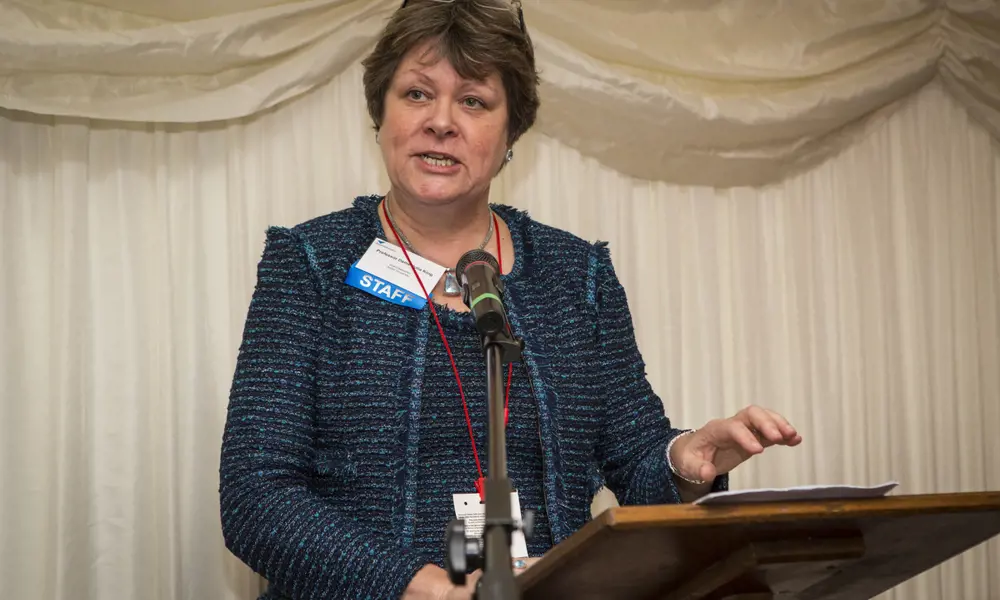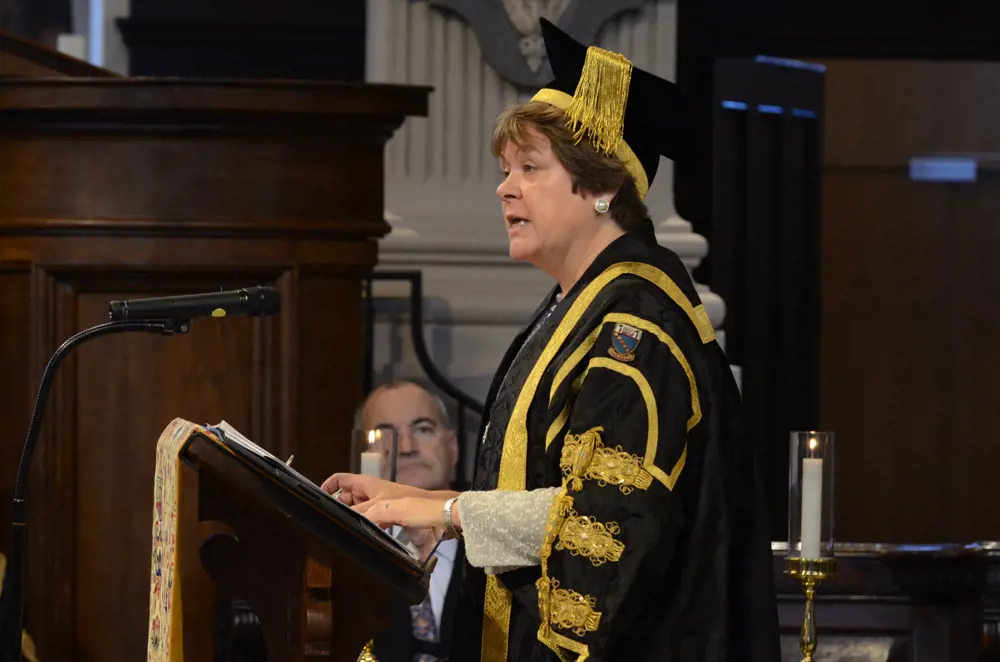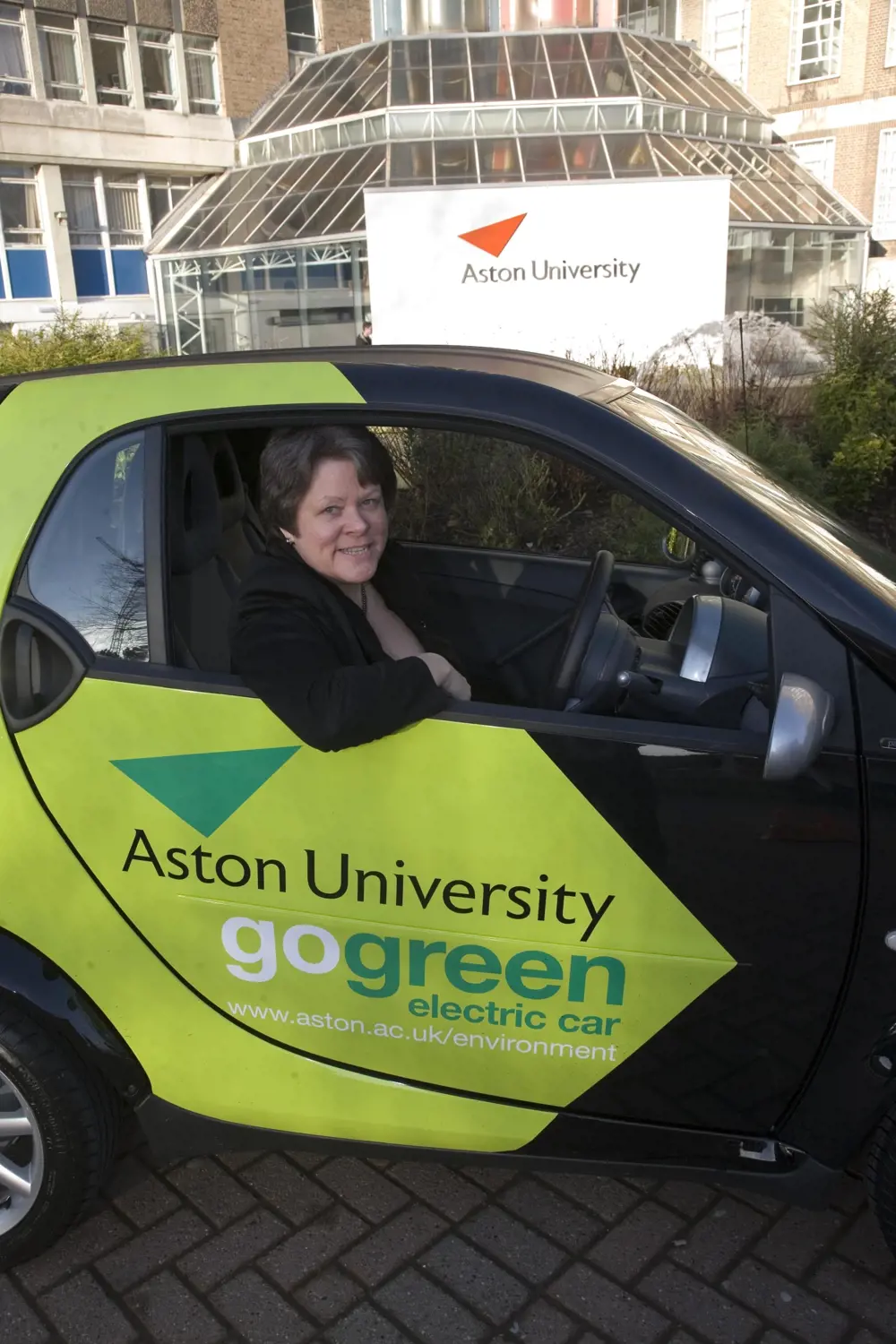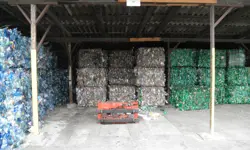
Forging links between academia and industry
In her journey from a West London girls’ school to the House of Lords, Julia King, Baroness Brown of Cambridge DBE FREng, has taken a far from typical path. She started on a traditional academic route, studying A levels in science and then natural sciences at the University of Cambridge, where she quickly abandoned thoughts of becoming a particle physicist. “When I got to university, I realised that I was much more interested in the problem-solving bit,” she says, so when looking for a PhD project, Baroness Brown turned to materials research, in particular fracture mechanics.
That PhD could have been the beginning of a traditional university career, ascending the academic levels to the heights of vice-chancellor. Baroness Brown did get that far, running Aston University between 2006 and 2016, but her journey there was varied. She started with 16 years at Nottingham and Cambridge universities, followed by almost a decade as a senior engineer with Rolls-Royce, before going back into academia.

Baroness Brown speaks at Aston University’s 50th anniversary at the Cathedral Church of St Philip in Birmingham in September 2016 © Aston University
Making connections
Baroness Brown’s links with Rolls-Royce date back to when she completed her PhD at the University of Cambridge and stayed on as a Rolls-Royce Research Fellow. She then joined the University of Nottingham as a lecturer. Most of her research students were “working on real problems and solutions to them” sponsored by industry, including Rolls-Royce. Her growing reputation in materials research led to her appointment as the Royal Academy of Engineering’s first Senior Research Fellow, supported by British Gas. Baroness Brown may have left Cambridge by this time, but her old colleagues had not forgotten her; a letter arrived inviting her to move her fellowship and her research team back to the university.
Reinforcing her contact with Rolls-Royce, it was around this time that the company was rethinking its approach to research, especially its university links. It decided to concentrate on bigger teams in a smaller number of groups, in what it dubbed University Technology Centres (UTCs). Rolls-Royce invited bids when it wanted to establish a UTC in nickel-base superalloys. The University of Cambridge won and Baroness Brown took on the task of establishing the new UTC.
It was not long before Frank Litchfield, the then director of component engineering at Rolls-Royce, invited himself to see the materials UTC. At first, Baroness Brown thought he wanted to check up on the academics. Instead, Lichfield invited Baroness Brown to “come and talk about a job”, and this resulted in her joining the company as Head of Materials. Bringing in an outsider, albeit one familiar with the aerospace business, was, she says, “very rare”. Rolls-Royce traditionally recruited engineers as graduate apprentices straight out of university and developed them through the company.
Bringing in an outsider, albeit one familiar with the aerospace business, was, she says, “very rare”
Some colleagues warned Baroness Brown that the move to industry could be a culture shock. “It was different,” she says, “but it wasn’t really a shock.” However, she does admit to mild panic when her eye caught the 25 bound-volume ‘quality system’ that she was supposed to keep up to date. “I found that a mystery,” she says with a laugh, “but quality was hugely important.” The materials Baroness Brown worked on went into critical parts of aircraft, so Rolls-Royce had to be able to prove to the regulators that its products were safe. “It used to worry me that they would come and find that we weren’t up to date with the quality manuals.”
Baroness Brown also found that the company’s engineers were not universally enthusiastic about what they saw as a move to outsource research, which they enjoyed doing, to the UTCs. As a result, they were not keen to act as go-betweens with the UTCs. They were also nervous about talking to academics about the company’s problems, in case secrets got out to the rest of the world.
Baroness Brown could see that the quality of the interactions between the company and the UTCs depended on the quality of the people at the interface. She also understood that 25 years in a company can lead to “a kind of group think” and the notion that there was a Rolls-Royce way of doing things. “To solve some of the technical challenges we had, we did need people coming in with different ways of thinking and solving problems,” she says. “We wanted the UTCs to stop us doing this ‘group think’ stuff that big companies are always in danger of doing.”
A change of role
Two decades on, the university/industry picture is very different. Things have changed a lot, says Baroness Brown. “Back then it really was two cultures. In [university] engineering departments there is now much more understanding about what industry needs.” Engineers in industry also have a better understanding that companies have to make profits. In the past, the company’s materials people loved the idea of developing futuristic new alloys. However, from the company’s point of view, says Baroness Brown, “looking for ways to increase the operating temperature and life of existing materials can have much a more immediate impact on profitability. The challenge was to get people from being most excited by their subject to being excited about delivering new products and making money.”
The challenge was to get people from being most excited by their subject to being excited about delivering new products and making money
The UTC system is now seen as a role model for companies working with universities, but challenges remain. “You have to work very, very hard at that interface all the time. We still haven’t cracked this problem of getting more people to move between universities and industry.” One suggestion, she says, is to have independent pensions that move with the worker. There are still some cultural differences between universities and industry. “But if there wasn’t a cultural difference it wouldn’t be worth doing the collaboration.”
After eight years in various roles at Rolls-Royce, Baroness Brown followed her own thinking on moving between domains. She admits that leaving Rolls-Royce was a case of circumstances and an approach from a headhunter. With the appointment of a new Rolls-Royce director of engineering, she could see that she would not get that job any time soon, so in 2002, Baroness Brown took up the offer of a job in London to run the Institute of Physics.
That plan, working somewhere between the business and academic worlds, did not last long. In 2004, she was offered the job of Head of Engineering at Imperial College London. Then two years later, the headhunters called again and, in December 2006, Baroness Brown became Vice-Chancellor of Aston University.
It was a really pragmatic and capable institution that was absolutely committed to giving opportunities to people
She confesses that, apart from a fleeting visit to Aston to a conference as a research student, “it was not a university I knew very much about”. Her impression of “a university in the middle of a motorway” changed when she discovered Aston’s approach to widening participation of students from communities that usually shied away from universities. “That was one of the things that attracted me to it. It was a really pragmatic and capable institution that was absolutely committed to giving opportunities to people. It manages to combine that with some very good research.” She is amused by the description of the university as delivering ‘employable graduates/exploitable research’, a slogan that prompted one publication to describe it as “one university that does what it says on the tin”.
Champion of research
Baroness Brown’s time at Aston coincided with significant changes in how universities are judged. In particular, the Research Excellence Framework (REF), the series of research benchmarking exercises carried out every five or six years since 1986, added a new measure of excellence. For the first time, the Higher Education Funding Council for England, the body that ran REF2014, asked universities to explain the impact of their research (‘Research with impact’, Ingenia 69).
Baroness Brown describes herself as a fan of REF’s impact assessment. “REF has been very helpful, particularly in science and engineering.” It has also been helpful in getting other disciplines to think about how their work is valuable outside the academic setting. “It is good for all disciplines to think about their impact.” She quotes work on forensic linguistics at Aston, where researchers are thinking about starting a company to help businesses to identify whether their communications are coming from the people they are supposed to be talking to, a relevant topic in these days of rising cybercrime.
There is this huge richness of data that should be being more strongly used by government and others, companies as well
In Baroness Brown’s view, REF’s database, which is getting on for 7,000 case studies, is a “fantastic resource” that companies, for example, can turn to in search of expertise. “The Engineering and Physical Sciences Research Council (EPSRC) has made really good use of REF,” she says, but the rest of the research community could do more with this resource. “There is this huge richness of data that should be being more strongly used by government and others, companies as well.”
Baroness Brown’s interest in REF, and her membership of Lord Stern’s review of the exercise, illustrates an increasingly important role for her as an active member, sometimes chair, of influential committees. She headed up the team that produced The King Review of low-carbon cars in 2008, a groundbreaking exercise, produced as a response to Lord Stern’s review of the economic impacts of climate change, which was one of those rare documents that did not disappear with a change of government.

For her ‘company car’ as Vice-Chancellor of Aston University, Baroness Brown opted for a small electric SMART car, which, when it was not being used for official business, was a big hit in visits to local schools where it helped to spread the message about climate change © Aston University
Green focus
Baroness Brown’s own interest in climate change has, if anything, become more pronounced. It influenced her work at Aston where, with some effort she admits, she persuaded the university to offer all second-year students a ‘stop the year’ week away from their courses, to work together on trying to reduce climate emissions. As Baroness Brown says, whatever they end up doing for a living, these are the people who will lead industry, universities and the other organisations that will have to adapt to the effects of climate change.
Climate change remains one of Baroness Brown’s major preoccupations. She is a Non-Executive Director of the Offshore Renewable Energy Catapult (see pages 30 to 35), and is one of eight independent members of the Committee on Climate Change (CCC). “I really enjoy the work,” she says. It gives her a chance to do something technical again, she adds.
Chaired by Lord Deben, the CCC provides “independent, evidence-based advice to the UK and devolved governments and parliaments”, setting carbon budgets, for example. Baroness Brown admits that the CCC can face an uphill struggle in trying to promote responsible policymaking. She explains: “We know that flooding is going to become an increasingly problematic part of our weather variation and yet we are still building in places that will be susceptible.”
We know that flooding is going to become an increasingly problematic part of our weather variation and yet we are still building in places that will be susceptible
Such issues will be a part of a fresh challenge for Baroness Brown as the new chair of the CCC’s adaptation sub-committee, taking in areas such as farming and health as well as the more familiar territory of economics and engineering. Baroness Brown remains active in these domains in another new job, as a Non-Executive Director of the Green Investment Bank. Set up and backed by the government to promote investment in the UK’s ‘green economy’, the bank has two key tasks: to deliver a financial return but also to deliver what she describes as “a green return”. She interprets her job at the bank as addressing the question: “How you describe the green bottom line?”.
A policymaker
The ability to turn back the floods may be beyond Baroness Brown’s skills, but as a crossbencher in the House of Lords, she is far from powerless in policymaking circles. She naturally takes a close interest in higher education and has been leading the way in discussions in the upper house about the government’s plans to change how universities operate in the UK.
The Higher Education and Research Bill sets out “to make provision about higher education and research; and to make provision about alternative payments [a student finance model that will be an alternative to a loan] to students in higher or further education”. Among the various problems that Baroness Brown sees is the bill’s lack of a definition of a university. Baroness Brown is not against changing universities, believing that some of the proposals will be good and will provide more choice for students. “It will give unconventional students much more flexibility in the degrees that they can acquire, but we do need to think hard about how we use the term university.”
Baroness Brown illustrates her concerns with an example. A registered higher education provider with 150 students in an office block may well be able to run a good course, teaching one subject to a very high level. “But I don’t think that is a university,” adds Baroness Brown. As the bill now stands, she explains, it allows the government and the proposed Office for Students to decide what constitutes a university. “We should be involved in that,” she says. “We should provide a checklist that says ‘It is a university if…’. I don’t think it is something that a civil servant can decide, without some strong guidance.”
She also has concerns about the bill’s possible impact on the fate of Innovate UK inside UK Research and Innovation, the new body that will bring it together with the research councils. She has submitted amendments to the bill to “strengthen a degree of independence for Innovate UK”. Culturally, she insists, Innovate UK has to be very different from the research councils. Its role is not simply to exploit ideas from universities, she insists. It has to be free to look at investing, as well as providing grants and loans. “We need to ensure that it retains its independence and business focus beyond the current players. It interacts a lot with business directly. We need to preserve that and make sure that it doesn’t get any harder.”
There is a lower unemployment rate among graduates. Forget about persuading those who do want to go to university to think about apprenticeships, and do something about the other 50%
For all her concerns about universities in the UK, Baroness Brown feels that “we worry far too much about higher education. We have good higher education. I get frustrated by the discussion that too many people are going to university, and that they should be doing apprenticeships.” There is a lower unemployment rate among graduates. Forget about persuading those who do want to go to university to think about apprenticeships, and do something about the other 50%. “That will make more difference to us than trying to persuade people not to go to university.”
Baroness Brown’s interest in education also takes in younger students. She is “very passionate”, a phrase she uses to describe many of her activities, about her role as chair of STEM Learning Ltd, a not-for-profit company that provides continuing professional development (CPD) for science teachers. “What we really need is for CPD to be compulsory for teachers,” says Baroness Brown. It is not just necessary to refresh teachers’ science knowledge and to introduce them to new ways of teaching, “it is also important to keep teachers motivated”. Baroness Brown believes that money for this work should be a part of schools’ budgets. “The cost of losing good teachers to the system is huge.”
Career timeline and distinctions
Born, 1954. Awarded a first bachelor’s degree in natural sciences, University of Cambridge, 1975. Awarded a PhD in fracture mechanics, University of Cambridge, 1978. Lecturer, University of Nottingham, 1980–1987. First Royal Academy of Engineering Senior Research Fellow, 1987. Senior engineering roles at Rolls-Royce, 1994–2002. Fellow of the Royal Academy of Engineering, 1997. Commander of the Order of the British Empire, 1999. Chief Executive, Institute of Physics, 2002. Principal, Engineering Faculty, Imperial College London, 2004–2006. Vice-Chancellor, Aston University, 2006–2016. Dame Commander of the Order of the British Empire, 2012. Life peer, House of Lords, 2015. Chair, Sir Henry Royce Institute for Advanced Materials, 2016–present.
Northern futures
Baroness Brown’s continuing interest in education and climate change does not mean that she has abandoned her original interest in materials and engineering. She is Chair of the new Sir Henry Royce Institute for Advanced Materials. Based in Manchester – with outposts already planned for Leeds, Sheffield, Liverpool, Imperial College London, Oxford and Cambridge universities, the National Nuclear Laboratory and Culham Science Centre – the institute starts with a budget of £235 million to build a new home “shoehorned into the campus” at the University of Manchester. It will have all the facilities and equipment needed to take materials research from laboratory to production line. “It needs to become the UK’s national institute for advanced materials. That is hugely important.”
With its home in the north west, the Royce, as she calls it, is seen as a part of the ‘northern powerhouse’. It has to support the economy of the north west, she says, and is “a huge responsibility. We have to make sure that the Royce is a national centre, for all of the community, that can provide the capabilities for a world-class materials sector across the UK.” It has to have its doors open to materials companies of all sizes as well as academics. Baroness Brown also hopes that companies will want to establish a physical presence in the new institute, and in those set up by partner organisations. She foresees a role for the institute working with the Catapults. “The Advanced Manufacturing Catapult is an obvious one.”
This time it will bring together as many universities and companies as possible
The institute also has to play its part in accelerating research out of universities, into existing companies or new businesses, she insists. Here, the Royce will have the advantage of the National Graphene Institute on its front door. Not only does that have facilities that are still under development, it also has an incubator, which is a building for accelerating applications and building new businesses. “That is a facility that I hope we will be able to share with them.”
One way of looking at the new institute could be to think of it as a nationwide version of the UTC that she set up in Cambridge with Rolls-Royce. This time it will bring together as many universities and companies as possible.
***
This article has been adapted from "Forging links between academia and industry", which originally appeared in the print edition of Ingenia 70 (March 2017).
Contributors
Michael Kenward OBE
Author
Keep up-to-date with Ingenia for free
SubscribeRelated content
Materials

Aerogels
Among some of the lightest known solid materials, aerogels, formed by removing liquid from gels, have many uses ranging from catalysts and sensors, to being used on NASA missions.

Recycling household waste
The percentage of waste recycled in the UK has risen rapidly over the past 20 years, thanks to breakthroughs in the way waste is processed. Find out about what happens to household waste and recent technological developments in the UK.

Diamond technology: beyond hardness
Diamond is being used in an increasing variety of industrial and technological applications, due to other properties in addition to its hardness. The UK is home to a wide range of diamond research, development and synthetic diamond production activities.

A lot more than lubrication
The control of friction and wear in mechanical systems by lubrication and surface engineering has led to safer, faster transport as well as medical innovations. Ian Hutchings FREng, GKN Professor of Manufacturing Engineering at the University of Cambridge, highlights the progress and some failures of the important discipline of tribology.
Other content from Ingenia
Quick read

- Environment & sustainability
- Opinion
A young engineer’s perspective on the good, the bad and the ugly of COP27

- Environment & sustainability
- Issue 95
How do we pay for net zero technologies?
Quick read

- Transport
- Mechanical
- How I got here
Electrifying trains and STEMAZING outreach

- Civil & structural
- Environment & sustainability
- Issue 95